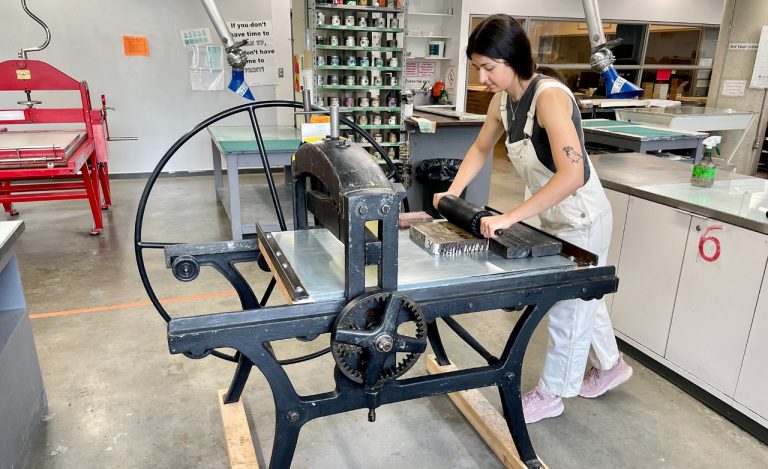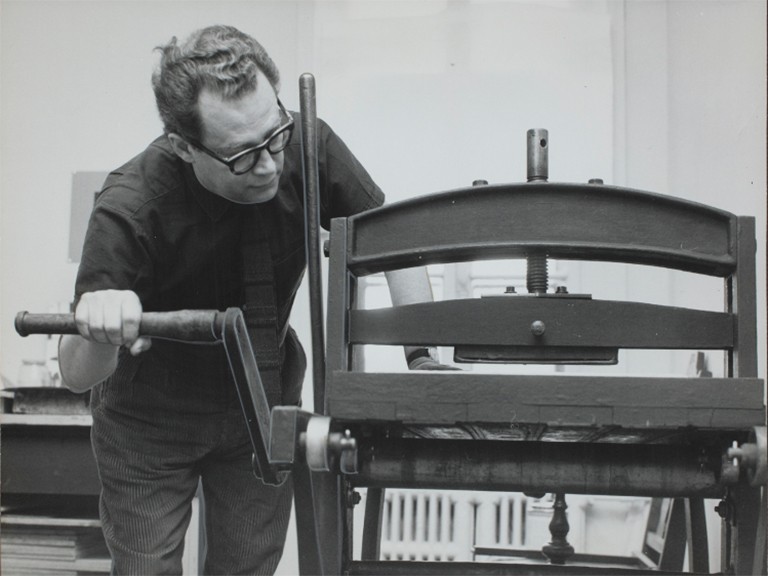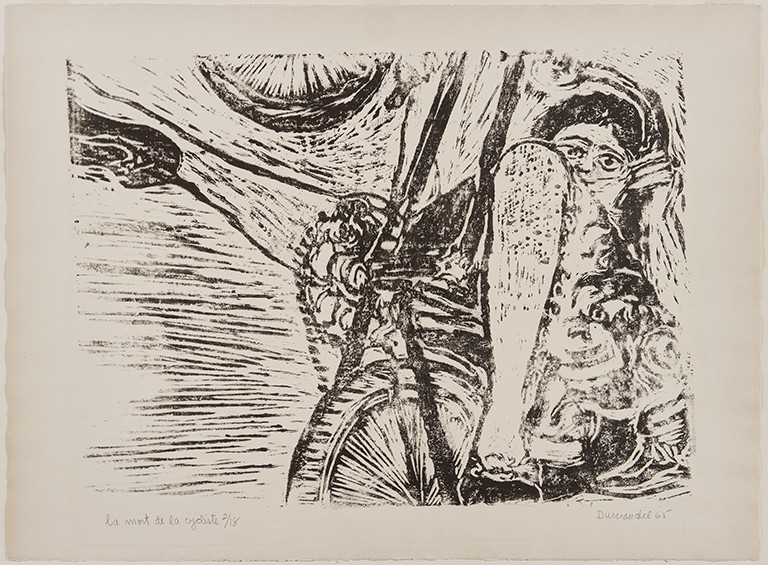Montreal artist supports the next generation of Concordia print-media students with lithographic press donation

Print-media students from Concordia’s Faculty of Fine Arts are making new works using the lithographic press once owned by notable Quebec printmaker and painter Albert Dumouchel. That’s thanks to a generous donation by Montreal artist Jason Cantoro.
Cantoro first gifted the more than 100-year-old press to the university in 2019 following conversations with Mitch Mitchell, associate professor of print media and chair of the Department of Studio Arts.
“Presses are quite rare and expensive, especially in Canada. Receiving one with such a special heritage is absolutely amazing,” Mitchell says.
“With nearly 100 students each term needing access to a press, the demand is high. Having this press in our arsenal has been a game-changer for student production and artistic education.”
Although Cantoro employed the press occasionally, his focus on screen-printing and painting meant it wasn’t seeing much use.
“I wanted to hang on to it for my old days. But, as a print enthusiast, I felt sad it wasn’t being used regularly,” Cantoro says.
“It needed repairs, and I figured that Mitch and Concordia could provide the best environment and restoration capacities.”
 Albert Dumouchel, circa 1965. | Photo: Paul-Henri Talbot
Albert Dumouchel, circa 1965. | Photo: Paul-Henri Talbot
‘Well-maintained presses will last forever’
In summer 2022, the disassembled press was fully restored and improved to meet students’ needs. It has seen constant use with the return of in-person classes over fall 2022 and winter 2023.
Mitchell says he initially thought a class or workshop might be an exciting way to restore the press, but due to the COVID-19 pandemic the restoration was largely done behind the scenes.
The professor worked with Alain Piroir, a master printer and gallery owner, to reassemble the press in its base form. Modifications and new components were then added to address the volume of student use. Some parts, including the wooden slab bed and 50-inch (12.7 centimetres) handwheel, were entirely remade, and the press was raised five inches (1.3 centimetres) for safety and ease of use.
“The great thing about old presses like this one is that if they are well maintained, they will last forever. And they cost less overall than the new current digital technologies that average a five-year lifespan,” Mitchell explains.
“Prints and artworks by Dumouchel that are now in national and international public collections were made on this century-old press,” he adds.
 Albert Dumouchel, “Death of a Cyclist,” 1965. | Courtesy of Montreal Museum of Fine Arts, photo: Annie Fafard
Albert Dumouchel, “Death of a Cyclist,” 1965. | Courtesy of Montreal Museum of Fine Arts, photo: Annie Fafard
Printmaker inspired ‘countless artists’
The Montreal Museum of Fine Arts (MMFA) recently showcased Dumouchel’s work with the retrospective Revelations. The exhibit featured nearly 40 of the artist’s prints, primarily drawn from the MMFA’s collection.
The exhibit curators, Anne Grace and Peggy Davis, explain that Dumouchel was an influential figure in the early days of printmaking in Quebec.
“Countless artists working in Montreal were inspired by the great printmaker Albert Dumouchel,” Grace says. “He was, by all accounts, a skilled and generous teacher, eager to push the boundaries of printmaking processes.”
Davis adds that the artist played a decisive role in the awakening of the art of printmaking in the province, both for the public and young artists.
“He trained the first generations of modern engravers. First, at the École des arts graphiques de Montréal, where he taught from 1940 to 1960, then at the École des Beaux-Arts de Montréal, where he began teaching in 1956,” she says.
“Dumouchel’s lithographic press embodies a spirit of collaboration and experimentation,” says Grace. “It is especially fitting for the setting of Concordia’s Faculty of Fine Arts.”
Student artworks celebrate Dumouchel’s legacy
For Mitchell, having students learn printmaking traditions and histories while creating new and exciting contemporary art with the press is the best way to celebrate Dumouchel’s legacy and Cantoro’s donation.
He shares that although the press is smaller than contemporary ones, students enjoy its unique and vintage qualities.
“The wonderful thing about printmaking presses is that they do not go out of date like computers and computer-reliant technologies,” Mitchell points out.
“Students love using the press because it slows the process down, forcing the artist to reconsider the moment of drawing and its impact. Pulling a physical print on a press is like a curious magic trick.”
Find out more about Concordia’s Department of Studio Arts.


